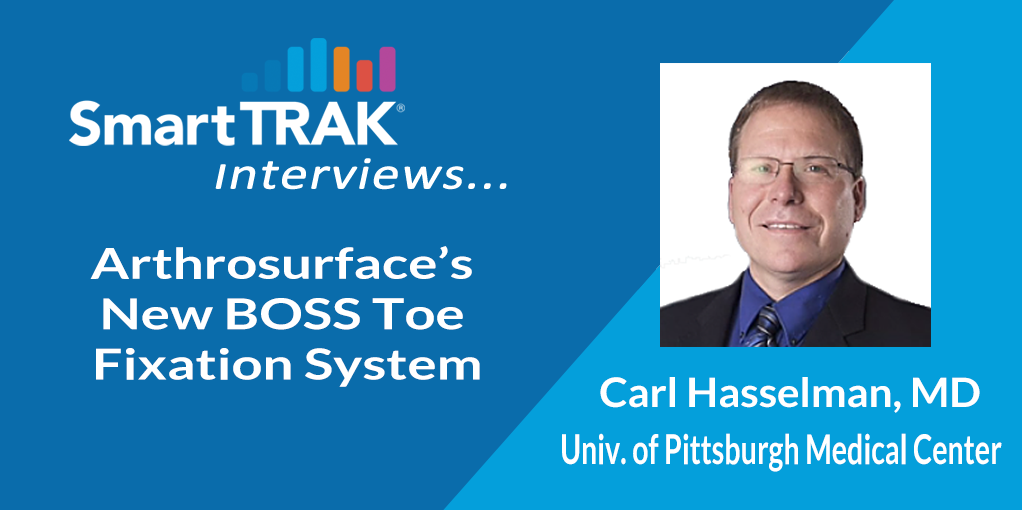 SmartTRAK Interviews Carl Hasselman, MD about Arthrosurface’s alternative to toe fusions
SmartTRAK Interviews Carl Hasselman, MD about Arthrosurface’s alternative to toe fusions
Arthrosurface showcased its new BOSS Toe Fixation System at the American Orthopaedic Foot & Ankle Society’s (AOFAS 2019) Annual Meeting held September 11–15 in Chicago, IL. Recently 510k cleared, the system improves stabilization in a first metatarsal with a distal bone void. The Boss Toe Screw fills the current product gap in implant solutions for failed synthetic implants. The system provides an option for patients who want to avoid a toe fusion while regaining motion and enjoying an active lifestyle.
To find out more about the new BOSS Toe Fixation System, its benefits, and how it fits in Arthrosurface’s existing line of HemiCAP DF implants and ToeMotion Systems, SmartTRAK interviewed Carl Hasselman, MD, University of Pittsburgh Medical Center, at AOFAS 2019.
To listen to SmartTRAK’s interview with Dr. Hasselman, click on the following video (11:14 minutes). A transcript of the interview is also provided below.
SmartTRAK: This is Natasha Weeks from SmartTRAK here with Dr. Hasselman, and we're going to be discussing Arthrosurface's new BOSS Toe Fixation System. Dr Hasselman, can you please tell us about the design and the technology behind the new BOSS Toe Fixation System?
Dr. Hasselman: Arthrosurface, back in 2004, created a metallic joint resurfacing for the metatarsal head, and it has enjoyed 15 years of tremendous success for the treatment of arthritis to the toe. Approximately five years ago they found the need for a phalangeal-sided component because sometimes we were seeing arthritis on the other side as well. Essentially it is a miniature knee replacement. It is the same concept, the same technology that you would see with a knee replacement. In fact, when I teach this around the country, I actually teach that it's an upside down knee replacement because the knee bends in the other direction. So, what happened was, it’s enjoyed tremendous success so far. Along came a newer implant, which is CARTIVA, where basically the concept is to drill an eight-to-10 millimeter hole in the metatarsal head and fill that hole with a plug of synthetic material. It has enjoyed success as well. The problem is we're seeing failures with that implant and they're not an insignificant number of failures.
When you have that situation as an orthopedic surgeon or podiatrist, your only option is to go in and to use the drill. A lot of people don't like that. So, the concept we've created is what's called the BOSS screw because in the metatarsal side there's a screw, a tapered post in the original design that went into the metatarsal end gap and gave us immediate fixation. The problem became when you have an 8 or 10 millimeter hole in the central part of the metatarsal head, your screw won't fit, or fill the hole. So, the BOSS screw is really just, it's the same implant on the outside, it's just the tapered post itself now has a large eight or 10 millimeter ring around it. Which is completely porous coated and it has small slots for bone to grow in.
So, what this screw has allowed us to do, is when you have a metatarsal head that has a large defect, you can use that screw to fill the defect to get immediate rigid fixation and then still put your cap on. So, the overall design hasn't changed. What makes the BOSS screw exciting is that we now have a way to fix a large defect in the metatarsal head, which we didn't before. The screw itself is just the exciting part because now we can actually deal with large defects created by synthetic implants.
“What makes the BOSS screw exciting is that we now have a way to fix a large defect in the metatarsal head, which we didn't before. The screw itself is just the exciting part because now we can actually deal with large defects created by synthetic implants.” Carl Hasselman, MD
When you mention the resurfacing components, are you referencing Arthrosurface's HemiCAP or the ToeMotion?
Dr. Hasselman: Correct. The HemiCAP. So the history of the company is in 2004, Arthrosurface first created a resurfacing called the HemiCAP. What we found is that we understood mechanics and rollback of the toe during this gait phase, and we learned that as you go from stance to toe off the actual shape or the mechanics of the toe changes. So, they created a small flange on the top of the metatarsal head to compensate for that and that became the DF. So, it went from HemiCAP to HemiCAP DF, and that was just that minor change. The ToeMotion implant is what came along five years ago when we realize the phalangeal side, it's the same concept on the DF side. A post if it goes into the screw and then only polyethylene is the resurfacing agent. In all honesty you could see that that's basically what a knee replacement looks like. You have it's shiny surface, you have polyethylene and then you have a metallic base. The only thing that DF really does is now gives us a way to still be able to put in the HemiCAP DF or the ToeMotion, but with large metaphyseal head defects created by silastic implants or any other thing.
The new BOSS screw, when would you use that? Is it solely just for when there's been a failed synthetic implant, or would you use it as primary fixation if there was arthritis of the MTP joint?
Dr. Hasselman: So, anytime I was going to do either the DF or the ToeMotion implants, if I had a metatarsal head that perhaps was osteopenic, or had a metatarsal head defect, or ENA failed silastic implant, those are the times I would use it. But in the normal regular metatarsal head, the original tapered post still works very well, and it has been. In the next year I'll have publications that show 15 years out that that implant still is holding up just fine.
I know you've mentioned that there have been quite a number of revisions with these failed synthetic implants. What would you say that revision rate has been where this implant's needed?
Dr. Hasselman: This is the point. So far, the problem with that is without this screw and what makes this screw exciting is it now gives a patient an option. Prior to this, it was all converted to fusion. Basically, everyone who had a failed implant went on to get fused. Now, you're giving the patient the option to maintain their motion by using a different implant. That's the biggest thing. I mean revision rates vary across the country, but it's been significant in the literature lately. Revision rates approaching 10, 15, even 20%. I would even say that's an under estimation. Sometimes the implant, and it's not necessarily, I'm not blaming the implant, sometimes it's the implant was put in for the wrong indication. Sometimes the implant was put in a much more advanced stage than what the implant plant was designed for. There's lots of different contributing factors. But when it fails and the patients still have pain, disability, this offers them something other than fusion.
“It now gives a patient an option. Prior to this, it was all converted to fusion. Basically, everyone who had a failed implant went on to get fused. Now, you're giving the patient the option to maintain their motion by using a different implant. That's the biggest thing.” Carl Hasselman, MD
Are there any clinical results so far with this Boss Toe?
Dr. Hasselman: Unfortunately, no because it just got FDA approved two weeks ago. In October, the implant will be available and I already have several patients waiting for this implant. So we'll begin that immediately. As soon as you start using it, we'll be collecting data for, you know, outcomes. The outcomes with the original post have been 15 years great. So, I have a funny feeling it will be just as good with the BOSS screw.
Looking into the future, do you feel that there still is a place for toe replacement as a treatment option, or with the introduction of new implants and technologies do you think it would be phased out eventually?
Dr. Hasselman: Just the opposite. It's funny, if you look at the history of the AOFAS and even in the podiatric world, 20 years ago ankle fusion was the absolute state of the art. That was the gold standard. People who are doing ankle replacements were experimental. Approximately 10 years ago, they said that ankle replacement and ankle fusion were similar and if you've not been to any of the meetings in the past couple of years they always argued about whose ankle replacements is the best. We're not even discussing fusion versus replacement. So, if you've seen that 20 year growth period for ankles, you're going to see the same thing for toes. There's a huge indication for joint replacement. The two joints, I feel, in the human foot and ankle area that really aren't well suited to fusion are the ankle and the great toe because both of those are used daily with toe off walking motion.
I think the problem with it is, is there've been implants in the past, most of them phalangeal sided, which did not have good outcomes. They had Silastic implants, they had horrible outcomes. When the Arthrosurface DF came out, they had imitators from other companies where they used fibrous posting and different techniques and unfortunately those failed. So, unfortunately the mentality still is that the implants don't work. But I can tell you I've been in practice for 20 years. I've been putting these in for almost 15 years, and I'm the kind of surgeon, if I do something, it doesn't work, I don't do it again. I've put in thousands of these. I have a lot of patients coming around the country to have me do their surgery.
People from other countries fly and have me do their surgery because they want a joint replacement. They want their motion. I feel that this is the solution to the problem. I do think CARTIVA has a role. I'm not, I'm not saying that. I'm saying that it has a role, but for more advanced arthritis, I think that joint replacement is where we're heading. I think that the Arthrosurface ToeMotion implant is that implant and it will be in the future. It's just we're in that growing phase. We're 20 years ago with ankles.
Is there anything else you'd like to share in conclusion about the system?
The only thing left goes back to you asked about the future and I think that those who aren't willing to step outside the box, if everybody would've hugged joint ankle fusion, we would never have where we're at with ankle replacement. We just have to change our mindset and take a serious look at this implant. I think that what you're going to find is yes, motion preservation with time will get better. As our patient population ages and stays active, I think you're going to see the demand for maintenance of motion is going to increase dramatically. So, you're going to see the market increase because you're seeing 70-year old’s out mountain climbing. You're seeing things that we didn't see even 20 or 30 years ago. So, people are not going to want their fusion, and they're going to want an alternative. I think joint replacement is going to hit that way.
All right, well thank you very much for your time.
Dr. Hasselman: My pleasure.







